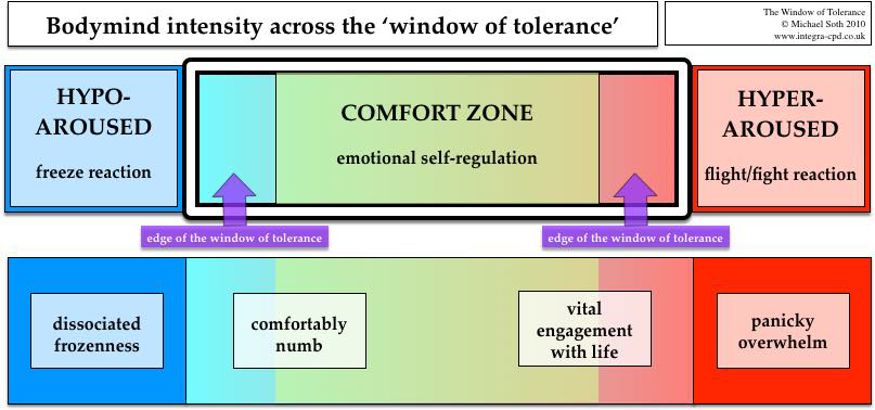Enrol in an online course today for flexible, self-paced learning—no fixed schedule required. Plus, enjoy lifetime access to course materials for convenient revisiting.
Working with the Breath

The significance of the breath in therapy
How much of the time, when you are with clients, are you having awareness of their breath and their breathing pattern? How much emotional significance do you attach to your client’s breathing, and how relevant do you think it is to their self-regulation and wellbeing? And what about the therapist’s own breathing – how much attention are we paying to that?
Although the influence of modern neuroscience and interpersonal neurobiology has put affect regulation centre stage in the therapeutic endeavour, the crucial role of breathing in regulating bodymind arousal is significantly underestimated. If the ‘window of tolerance’ can be pictured across a spectrum between panicky overwhelm to vital engagement with life to comfortably numb to dissociated frozenness, then the breathing pattern is the most immediate indicator and manifestation of a person’s experience on that spectrum.

Would you know what instructions to give to help your client breathe in a way that calms a panic attack? Or to change the breathing pattern of a client in a frozen state in order to vitalise their experience?
If we want to bring the two bodies constituting the therapeutic relationship fully into the consulting room, we need to not only understand, but learn to actively work with the breath – the client’s and our own, and the connection between them – as part of the emotional, psychological and intersubjective embodied encounter.
In this learning, we can draw from a wide range of different – and quite contradictory – traditions, which have been exploring and using the breath, some of them for several decades, some of them for millennia. These include both Eastern and Western traditions, many explicitly holistic, some psychological, as well as a wide range of complementary therapies and bodymind practices.
Diverse traditions, contradictory principles, a multitude of techniques
But in our eagerness to validate somatic experience, the inherent differences and contradictions between these traditions can get ignored. We then end up with a smorgasbord of techniques that are all presumed to work towards a common goal, but are actually profoundly contradictory, and end up pulling the process in different directions. The client’s bodymind then feels uncontained, confused and fragmented, not sure whether it is coming or going. If you’re interested in reading more about the tensions and contradictory principles between the diverse traditions of different kinds of breath work, you can read my detailed article here.
Eastern breathwork traditions
Generally speaking, the Eastern traditions – including yoga, meditation and the martial arts – focus on belly breathing, and mindful centeredness in the ‘hara’ (the centre of the body, just below the navel). They are therefore oriented towards a calming, unifying, steadying effect. They were never designed to deal with the degree of disembodiment, traumatised dissociation, repressed feelings, and general neurosis of the modern psyche and its fragmentation. But as holistic practices affecting not only our body, but also our state of mind, they can have profoundly beneficial and therefore therapeutic effects.
Western breathwork traditions
In contrast, the more recent Western traditions of working with the breath, starting with Reich’s vegetotherapy in the 1930’s, were focused precisely on addressing disembodiment and repressive ‘character armour’. They primarily emphasised catharsis in order to counteract chronic tensions, inhibitions and restrictions of the breath. Many humanistic approaches descend from that origin, or at least pull in the same direction – for example, primal therapy, rebirthing, Grof’s holotropic breathing and other cathartic methods. Being focused on losing control, these techniques constellate fears of regression, and have generated both valid concerns and uninformed prejudice.
The unexplored tension between Eastern and Western approaches to the breath (‘mind’-ful, calming, centering versus charging, ‘mind’-less expressive, cathartic) is pervasive across the body-oriented therapies. But it is not the only contradiction pervading the field of breathwork.
The crucial relational ingredient in breathwork
When a therapist is giving any kind of instruction or suggestion, a key question is always: whom does the client experience this intervention as coming from in the transference? So before I deliver any kind of intervention – however ‘right’ I think it is in terms of the client’s current bodymind process – I first want to ask: who is intervening in relation to whom? Or in other words: how is this intervention also being experienced as an enactment?
Having some fantasies and ideas about this helps me better understand the non-verbal feedback I perceive in response to any kind of intervention. It therefore constitutes a crucial ingredient in any kind of embodied-relational breathwork.
‘Working with the Breath in Psychotherapy’, a CPD weekend in Devon with Michael Soth, will take place on May 26-27 2019. For further information, see the event page on the INTEGRA CPD website. You can read more of his writings at integra-cpd.co.uk, or find him on Facebook and Twitter (INTEGRA_CPD). He is co-editor of the Handbook of Body Psychotherapy and Somatic Psychology, published in 2015.


















